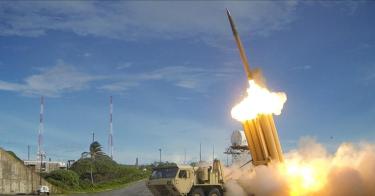Between a new health care bill and a potential government shutdown, there is plenty for the White House and Congress to do. But amid this, U.S. President Donald Trump summoned the entire Senate for a special briefing on North Korea. I hope they discussed not only North Korea’s ballistic missile programs, but also our ballistic missile defense, or BMD, infrastructure.
Many senators have opposed BMD. They failed to stop its development under President George W. Bush and have waged a campaign of obstruction by continuously pushing for delays to “improve and mature” the technology. In the face of North Korean threats and capabilities, we need improved BMD today, not years down the road.
Maj. Gen. Francis Mahon, former director of test at the Missile Defense Agency, called on Congress to support MDA's plan for a redesigned kill vehicle.
"The next step to further improvements should be a prudent, evolutionary path to a redesigned kill vehicle," Mahon said in a 2015 commentary. "The other kill vehicle concepts have merit, but if pursued in lieu of the redesigned kill vehicle, they deny the war fighter necessary near-term capabilities for virtual promises that rarely deliver on schedule or in budget. This nation cannot afford to gap our missile defense capability."
We must heed Mahon’s call to action.
What we have now
A key component in our defense against the threat of a missile attack is the exoatmospheric kill vehicle. It's the bullet that hits a bullet; a state-of-the-art projectile launched from ground-based interceptors, or GBI, in Alaska and California that destroy targets in space.
The MDA has invested significant resources in developing the most successful kill vehicles ever. These warheads, on the Standard Missile-3, or SM-3, and GBI have delivered more than three dozen exoatmospheric intercepts.
Build on success
With billions and countless man hours invested, the most cost-effective solution to finding a next-generation kill vehicle is to re-engineer what already exists. In the same way, America did not stop improvements on propeller aircraft when we began using jets: “Moving ahead with revisions and upgrades to proven existing technologies while experimenting with radically new designs.” That lesson cannot be forgotten.
In a recent panel, Rear Adm. Jon Hill, deputy director of MDA, stressed that the U.S. must be cost-effective, and in order to do that, it should take advantage of the technology it already has. His emphasis on existing technology is critical; others agree. Vice Adm. James Syring, director of the MDA, indicated that the long track record of the kill vehicle on the SM-3 is what we must build upon. Lt. Gen. Edward Anderson, the former head of Army Space and Missile Defense Command, wrote: "This redesign is hardly a 'band-aid' as some have reported; it will provide performance enhancements and reliability upgrades by leveraging existing SM-3 technology. This is the lowest-risk, lowest-cost option to ensure our homeland is protected in the near-term."
New ideas, yes, but don’t forget what works now
Congress must support the MDA’s plan to pursue a short-term redesign of the current kill vehicle. Sticking with what we have and improving it is the lowest-risk, most cost-effective option. Given the myriad of potential threats facing the U.S. homeland, our military does not have luxury of building a totally new program from the ground up.
The U.S. needs a long-range solution to the threats, which continue to grow. The technology known as the Multi-Object Kill Vehicle appears to be that solution. The MOKV should be developed in the coming years; however, scrapping the current concept is too risky. It should not be an either/or scenario. If there were no threats out there, America could afford the luxury of waiting for the MOKV.
That is not the case.
North Korea is rapidly approaching a delivery capability that can hit vital U.S. targets. They are likely to get to their end state before we could develop a revolutionary new defense like the MKOV. America can achieve the goal of a redesigned kill vehicle before North Korean leader Kim Jong Un could strike. That is the direction we must go, and there should be no further delay or debate. Build on the proven capability and protect American lives.
This piece originally appeared in DefenseNews





